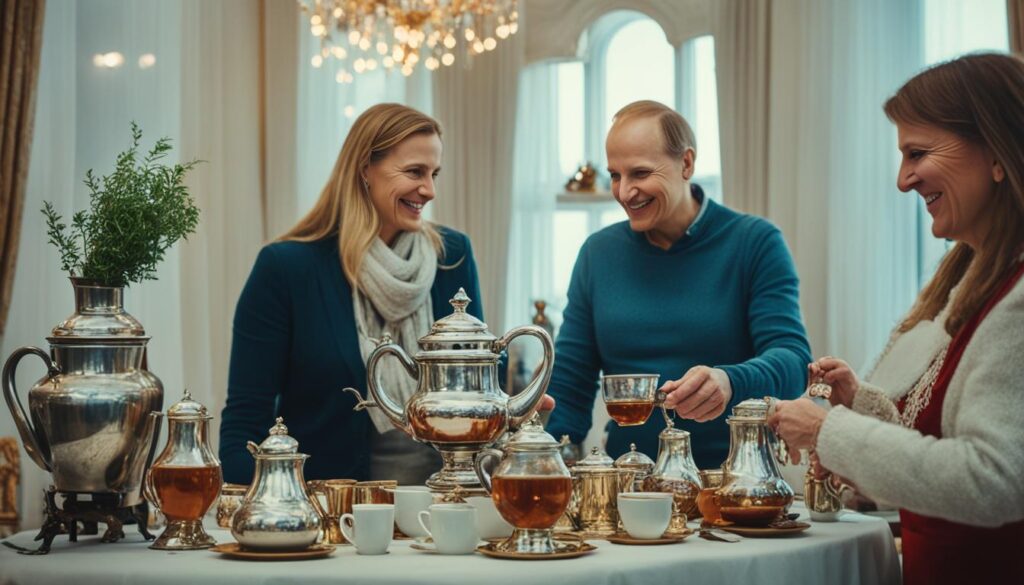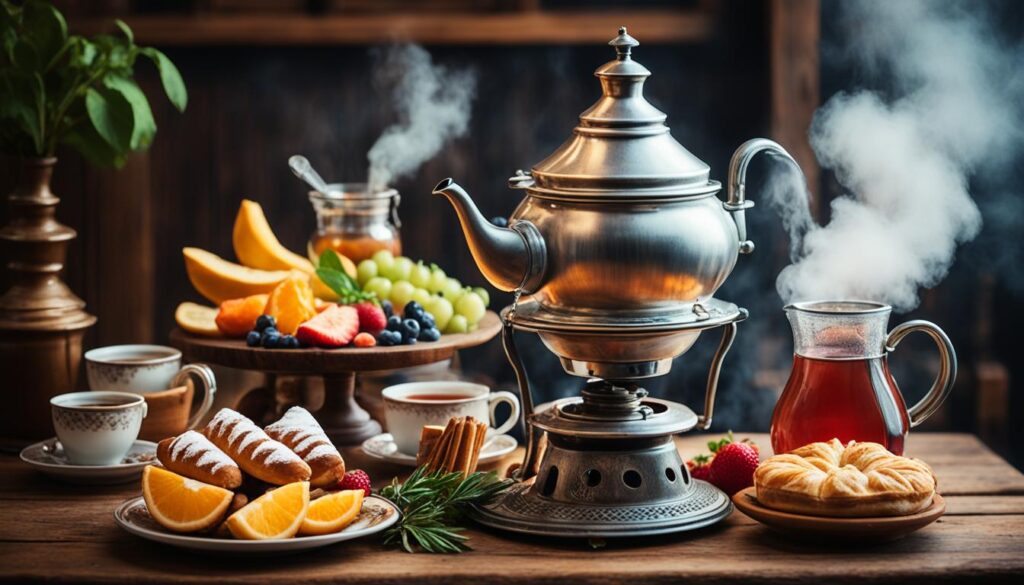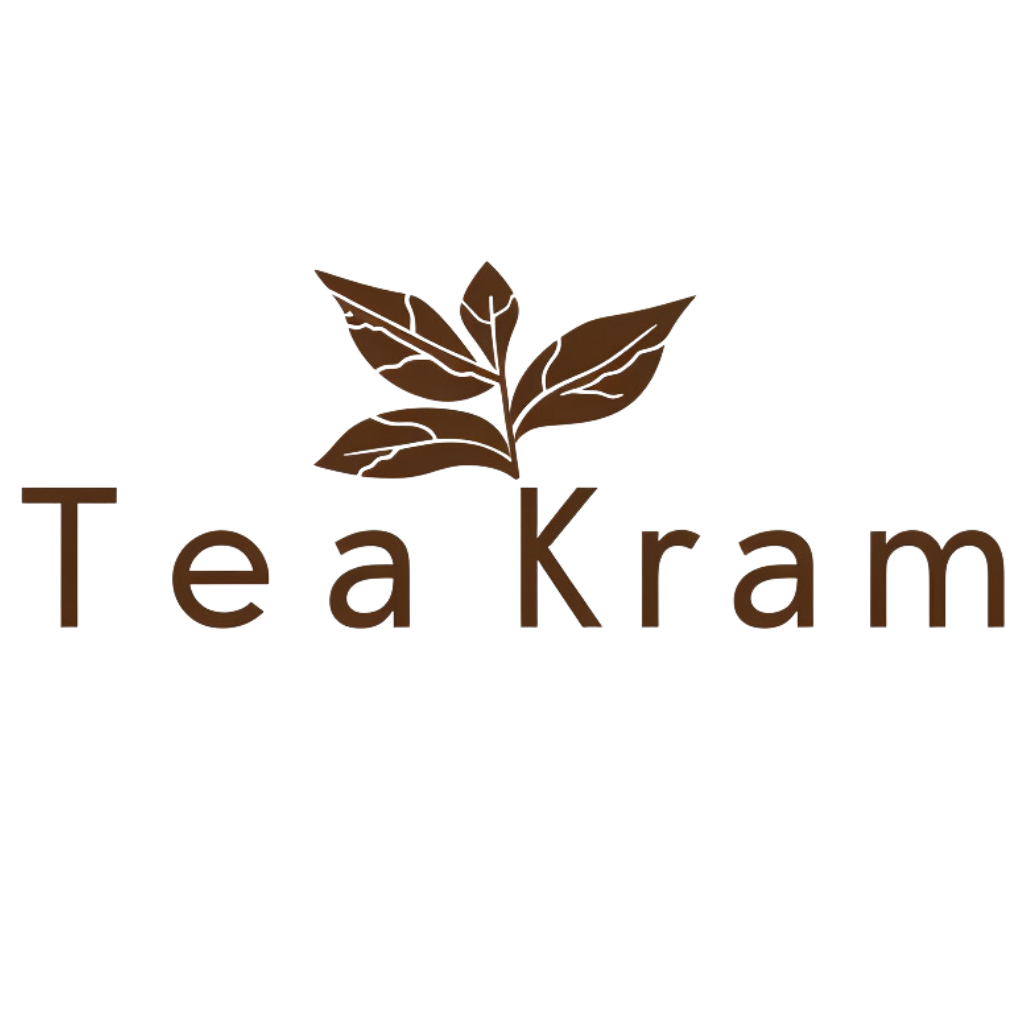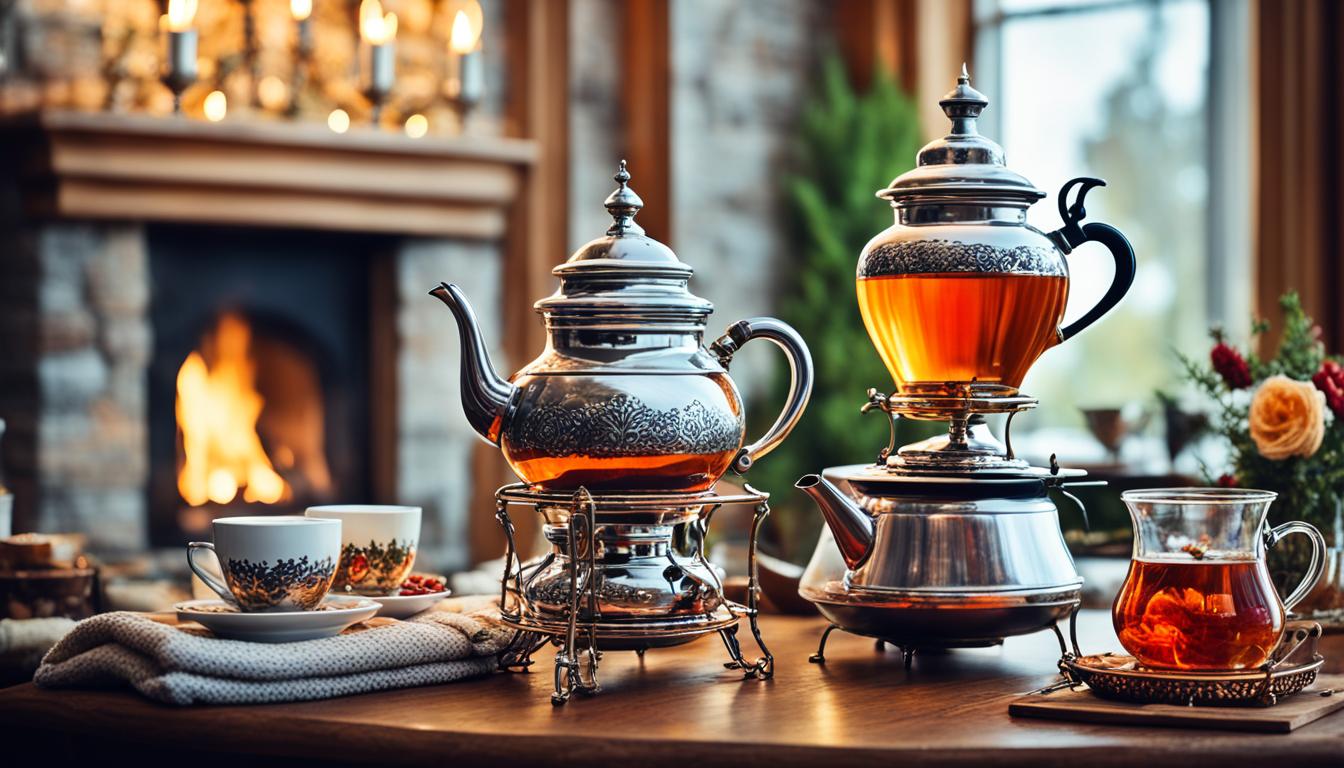In the realm of cultural expressions, few traditions resonate with the warmth and generosity synonymous with Russian hospitality as eloquently as the serving of Russian Samovar Tea. More than a mere beverage, this age-old custom weaves a rich tapestry of social connection, offering a hospitable hand to friends, family, and guests alike. It stands as an unwavering Symbol of Hospitality, a testament to the ingrained values of unity and communal spirit that Russian tea and hospitality have epitomized over centuries.
This aromatic infusion, cradled in the quintessentially Russian Samovar, tells a story of welcoming and kinship. The steaming vessel is not just a centerpiece for a gathering, but a vessel through which stories are shared, and bonds are forged. As we explore the depths of this heartwarming ritual, we unravel the threads that make Russian Samovar Tea an enduring emblem of a culture steeped in generosity and warmth.
Key Takeaways
- The ritual of serving Russian Samovar Tea is deeply interwoven with the country’s hospitality and cultural identity.
- Samovar tea is appreciated beyond its flavor – it’s a gesture that fosters warmth, connection, and conviviality.
- Understanding the ceremony and craftsmanship of Samovar tea enriches the appreciation for this Symbol of Hospitality.
- The practice of sharing a steaming teapot from a Samovar continues to be a gesture of kindness in the modern era.
- Embracing the art of Samovar tea is not only a nod to tradition but also a celebration of the Russian spirit of openness and sociability.
The Heart of Russian Tea Culture
Stepping into the world of Russian tea traditions unveils a history steeped in warmth and communal spirit. Central to this experience is the Samovar, not just a tea kettle, but a hallmark of Russian tea culture. The rituals and practices surrounding the Samovar illustrate a narrative of social hospitality deeply entrenched in Russian heritage.

The Origin and History of Russian Samovar Tea
Tracing back to the 18th century, the importance of Russian Samovar Tea manifests as both a practical item and a symbol of unity. Born out of necessity in a nation that reveres tea, the Samovar emerged as a communal focal point, fostering interaction and social warmth.
Understanding the Samovar: A Ceremonial Centerpiece
The Samovar, an iconic figure in traditional Russian tea settings, is intricately designed to facilitate the Samovar tea ceremony—a ritualistic affair that celebrates the act of tea-making and serving as a form of hospitality.
How Russian Tea Aligns with Social Hospitality
Integral to the notion of Samovar tea and hospitality is the communal nature of Russian tea drinking. The practice sets the stage for an intimate gathering, turning strangers into friends and reinforcing bonds within the community.
Examining the Aesthetic of Samovar Craftsmanship
The Samovar is a manifestation of exquisite Russian artistry, embodying traditional patterns and ornate detailing. Each piece tells a tale, reflective of the regional diversity and the rich Russian tea traditions and symbolism that each region holds dear.
- Origins: A Legacy of Russian Hospitality
- Design: A Blend of Function and Elegance
- Ceremony: The Choreography of Samovar Tea
- Manufacturing: The Craft That Creates Heritage
Russian Samovar Tea: A Symbol of Hospitality
The Russian Samovar is not merely a vessel for brewing tea; it is deeply interwoven with the fabric of Russian tea culture, standing as a stout symbol of hospitality. To understand its revered position, one must delve into the anecdotes and traditions that paint a vivid picture of the Samovar’s role within the domestic sphere. It is the hearth around which families gather, the centerpiece to countless tales of kinship, and a beacon that signals the readiness to pause, connect, and extend a warm welcome.

Often, the Samovar is subject of stories passed down through generations, encapsulating the spirit of open-handed hospitality. It represents a gateway to shared experiences, a conversation starter, and a silent promise of comfort and care, lavishly given to both friend and stranger. The art of preparing Russian Samovar Tea is an intimate dance, its steam and warmth fill the home, whispering of longstanding cultural traditions and the universal language of hospitality.
Embracing guests with a steaming cup of tea from the Samovar is a gesture that transcends barriers, creating a stirring sense of belonging and contentment.
- Representative of Generosity: The Samovar’s presence at social affairs is a testament to the hosts’ readiness to serve and indulge their guests in the finest teas.
- Center of Social Interaction: The act of sharing Russian Samovar Tea naturally gravitates people together, fostering interactions laced with warmth and sincerity.
- Time-Honored Custom: Each pour, steeped in tradition, continues to reinforce the values of communal harmony and gracious entertaining.
The Samovar’s ornate form and ceremonious use during tea time do more than serve a drink; they exhibit the timeless Russian etiquette that venerates togetherness. As a symbol of hospitality, the Russian Samovar Tea ritual is both a cornerstone of family life and a cultural treasure, a bastion of cordiality that harks back to an era when time moved slower, and moments of fellowship were savored like the sweetest of teas.
Conclusion
The threads of Russian tea traditions weave through the fabric of time, continuously catching the admiration of onlookers worldwide. The Russian Samovar Tea, laden with history and sentiment, crafts an indelible portrait of Russian tea culture, embedding itself as the quintessential Symbol of Hospitality. As we peer into the mosaic of traditions, it becomes evident that these customs extend beyond mere rituals, carving out a niche of Modern Hospitality that resonates with people across the globe.
The Lasting Impression of Russian Tea Traditions
Russian tea and hospitality boast a universal language that speaks to the heart of every guest, leaving a lasting impression through its ritualistic warmth and the communal bond it fosters. It’s this very emblematic cultural fixture that magnetizes people towards the hospitable nature of Russian society. Even in the farthest corners of the world, the essence of a Russian samovar steaming amidst friends and family symbolizes an unspoken yet deeply understood welcome.
Samovar Tea’s Role in Modern Hospitality
In the shifting sands of time, Samovar Tea has found its niche within modern hospitality, adapting its ceremonial splendor to contemporary exigencies. In Russian-inspired establishments and homes alike, the Samovar remains a proud proclaimer of culture and heritage. With the integration of tradition and innovation, Preserving Russian Samovar Tea has become more than a practice — it signifies a commitment to cultural identity and the timeless values that come with it.
Preserving the Warmth of Russian Samovar Tea for Future Generations
With an eye towards the future, nurturing a deep connection with Russian tea traditions takes precedence. Cultural initiatives and educational programs are at the forefront of sharing the knowledge and skills involved in Samovar tea-making. The meticulous transfer of this craft from one generation to the next is essential in safeguarding the essence of the Samovar. Through these heartfelt efforts, we see a promise—a promise to keep the embers of Russian Samovar Tea glowing for many years to come, allowing its warmth to welcome the world, one cup at a time.
FAQ
What is the Russian Samovar and why is it considered a symbol of hospitality?
The Russian Samovar is a traditional device used to heat and boil water for tea, central to Russian tea culture. Beyond its practical function, it is seen as a symbol of hospitality due to its central role in social gatherings. Serving Samovar tea is a warm gesture of welcome and a way to connect with guests, building relationships over a shared pot of tea.
How did the tradition of serving Russian Samovar Tea begin?
The tradition of serving Russian Samovar Tea began in the 17th century and gained prominence in the 18th and 19th centuries. It originated as a convenient way to serve hot beverages, especially tea, which was growing in popularity. Over time, the Samovar became a staple in Russian households, signifying not only a readiness to serve guests but also a status symbol and an artful expression of craftsmanship.
Can you describe the process of preparing tea using a Samovar?
Preparing tea using a Samovar involves filling the main body with water and lighting the fire within the pipe in the center to boil it. A small teapot is placed atop the Samovar, where concentrated tea, called zavarka, is brewed. The hot water from the Samovar is then mixed with the zavarka in individual cups, creating a beverage of desired strength. The process is often sociable, allowing hosts and guests to partake in the preparation and serving of the tea.
What role does Russian tea play in social gatherings?
Russian tea plays an essential role in social gatherings as it is synonymous with hospitality and comfort. Serving tea from a Samovar is a communal event, fostering a warm and welcoming environment. It encourages conversation, bonding, and the sharing of stories, creating a friendly and intimate setting that is central to Russian social traditions.
Why is Samovar tea more than just a beverage in Russia?
In Russia, Samovar tea represents more than just a beverage; it embodies a tradition of hospitality, warmth, and social interaction. It is a cultural ritual that expresses friendliness and generosity, encouraging people to slow down, enjoy each other’s company, and appreciate the moment. The Samovar itself, as a physical object, has also become an heirloom that passes from generation to generation, symbolizing the endurance of these cultural values.
What is the importance of aesthetic and craftsmanship in Samovar manufacturing?
Aesthetic and craftsmanship play a vital role in Samovar manufacturing, as each Samovar is not just a utensil but a work of art. Traditionally made from metals like brass, bronze, or silver, and often adorned with intricate designs, Samovars showcase the skill and artistry of the craftsmen. They reflect cultural identity and pride, contributing to their status as treasured possessions in Russian homes and as objects of cultural heritage.
How does the modern interpretation of Samovar tea ceremonies fit into contemporary life?
Modern interpretations of the Samovar tea ceremony find a balance between honoring tradition and adapting to contemporary life. While urbanization and technology have changed the way people live, there is a renewed interest in preserving and experiencing traditional practices. Today, modern Samovars may be electric, and contemporary tea service may pair traditional elements with new conveniences, allowing for the continued appreciation and enjoyment of this historical ritual in a modern setting.
What initiatives are in place to preserve Samovar tea traditions for future generations?
Various cultural initiatives and educational programs are dedicated to preserving the Samovar tea traditions. These include workshops on Samovar craftsmanship, tea ceremonies, and cultural exchanges which impart knowledge of the historical and cultural significance of the Samovar. Museums and cultural centers also play a role in showcasing Samovars and their history to the public. Such efforts ensure that the appreciation of Russian Samovar Tea and its traditions are maintained for future generations to experience.



